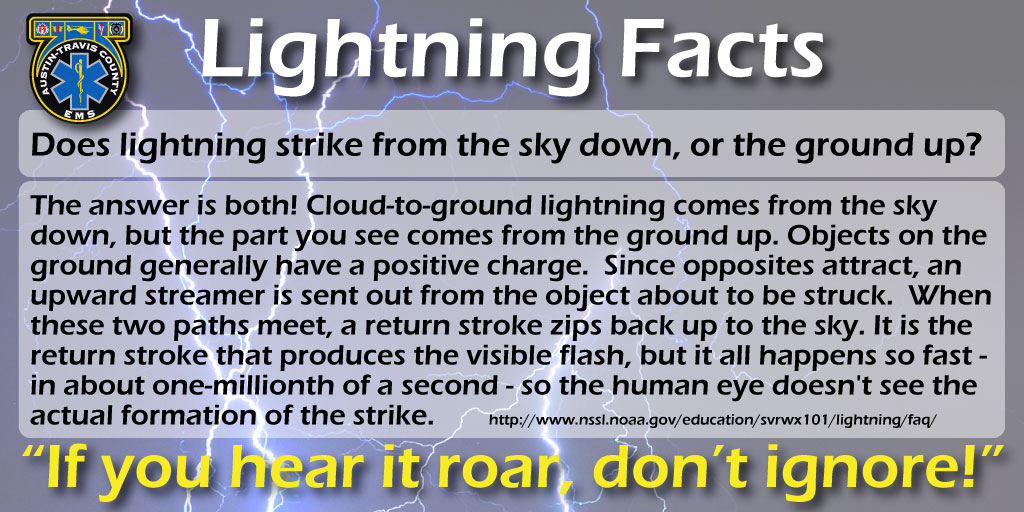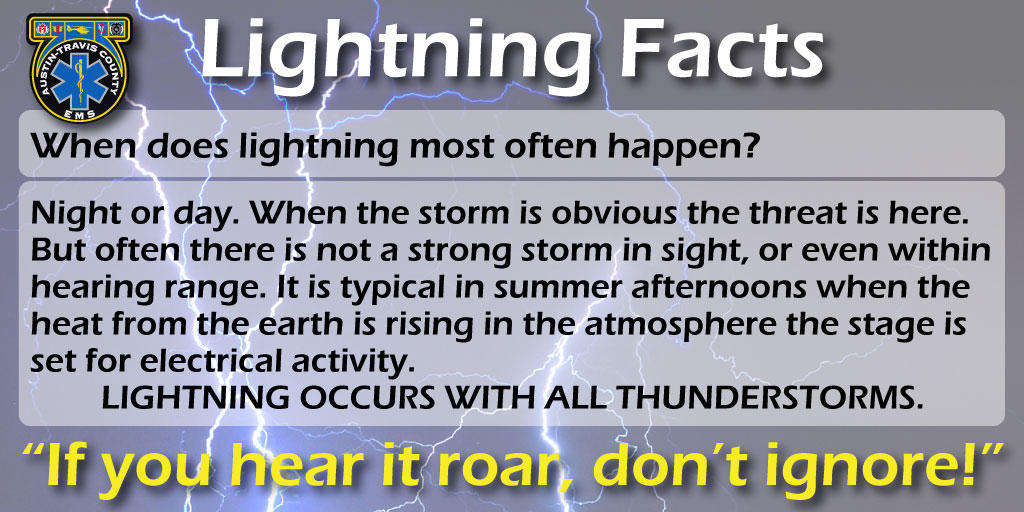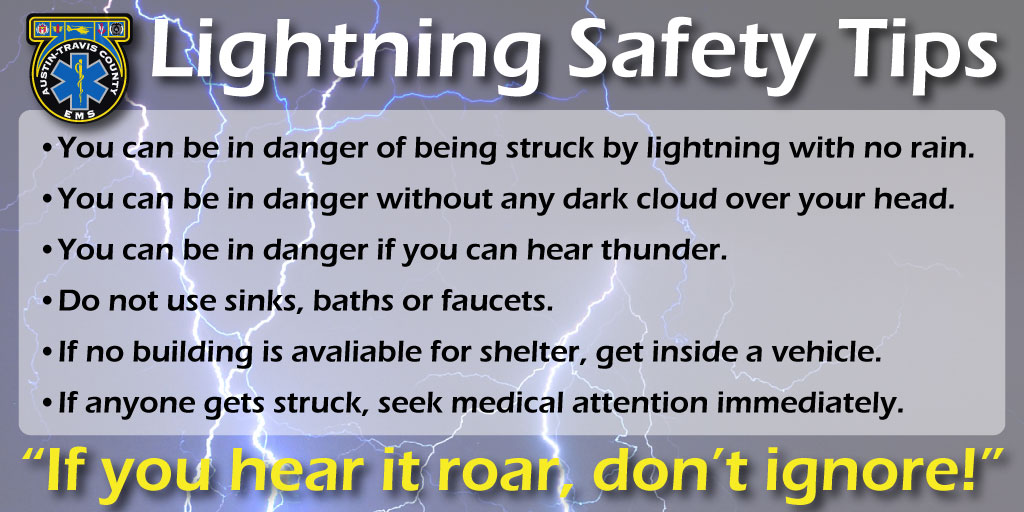Preventing Heat Emergencies and Hyperthermia
Vehicle Heat Safety
Lightning Safety
Hiking Safety
Bee Safety Tips
Preventing Heat Emergencies and Hyperthermia
Stay Safe in the Summer Heat
Our Central Texas summers are filled with plenty of outdoor activities and fun in the sun. If you are planning on being outdoors on a hot summer day you can take simple precautions to keep you and your family members safe from the summer heat. Stay cool and make simple changes in your fluid intake, activities and clothing during hot weather to help reduce the risk of hyperthermia and heat stroke.
- Pack your cooler with water, ice and cool packs or cloths. Avoid caffeinated and alcoholic beverages which are diuretics and can dehydrate you.
- Dress for the heat in loose, light colored clothing, wear a hat and use sunscreen.
- Stay hydrated and drink more water than usual, 2 to 4 eight ounce cups of water every hour when outside for long periods of time, and when performing strenuous work or exercise.
- Don’t over-exercise, take breaks and seek the shade or air conditioning to cool yourself down.
- Keep an eye on children, pets and the elderly for signs and symptoms of heat exhaustion and heat stroke.
Warning Signs and Symptoms of Heat Emergencies
Signs of Heat Exhaustion
- Heavy sweating
- Weakness
- Cold, pale and clammy skin
- Fast, weak pulse
- Nausea or vomiting
- Urine dark in color or lack of need to urinate; you should urinate at least once every 3-4 hours
What to do:
- Move to a cooler location
- Lie down and loosen your clothing
- Apply cool, wet cloths or compresses to as much of your body as possible
- Sip water
- If you have vomited at it continues, seek medical attention immediately
Signs of Heat Stroke
- High body temperature (above 103 degrees F)
- Hot, red, dry or moist skin
- Rapid and strong pulse
- Possible unconsciousness
What to do:
- Call 9-1-1 immediately--THIS IS A MEDICAL EMERGENCY
- Move the person to a cooler environment
- Reduce the person's body temperature with cool cloths or even a bath
- Do NOT give the person fluids
Don't Forget Our Furry Friends
Pets can get dehydrated quickly, so make sure you take precautions to keep your pet safe.
- Give your pet plenty of water when it’s hot outdoors. Make sure to fill their water bowl before you leave.
- Make sure they have a shady place to get out of the sun.
- Be careful not to over-exercise your pet. Too much playtime in the hot sun is dangerous for them.
- Hot asphalt and tar can burn sensitive paw pads, walk your pet on grass or dirt when possible.
- Keep your pet indoors when it’s extremely hot outside.
- Never leave your pet in a car! Pets can overheat in minutes so don’t put them at risk! Leave them home in hot weather.
FINAL NOTE: MILD HEAT EMERGENCIES CAN QUICKLY AND CONTINUALLY PROGRESS TO SEVERE HEAT EXHAUSTION AND HEAT STROKE IF LEFT UNTREATED.
Never leave a living thing unattended in a motor vehicle!
Heat related motor vehicle emergencies are entirely preventable, see below for ways to keep your loved ones safe. For other ways to help keep your family, friends, and pets safe this summer download our Hyperthermia brochure (English version or Spanish version) for lifesaving information
NEVER Leave Children or the Elderly Alone in a Car
Never leave children or an elderly person unattended in the car, even to run a quick errand. A child’s body can heat up five times faster than an adult’s and even in cooler weather, cars can heat up to dangerous temperatures very quickly. In as little as three minutes in the sun, a car's interior temperatures can heat up from 78 to 100 degrees, putting your loved ones in danger of hyperthermia or heatstroke. On a mild day, the temperature inside a car can rise 20 degrees above the outside temperature in just 10 minutes or less.
- Make a habit of checking your vehicle before leaving it. Look before you lock!
- When a child is missing, check vehicles and car trunks early in your search.
- Keep vehicles locked at all times even in the garage or the driveway to ensure kids don't get in on their own. Keep car keys and/or keyless remote openers out of the reach of children.
- Creat a reminder for yourself by putting something you'll need in the back seat of your car next to your child like your cell phone, handbag, employee ID or brief case, etc...
If you ever see a child or an elderly person alone in a car, get involved. If they are hot or seem sick get them out as quickly as possible. Call 9-1-1 or your local emergency number immediately!
Don't Forget Our Furry Friends
Never leave pets unattended in the car, even to run a quick errand. Pets can suffer serious injuries when left in a hot car for only 15 minutes. Keep in mind that pets maintain a higher body temperature than humans and can't cool down as efficiently. Your pet can suffer heat related injuries like hyperthermia and heatstroke.
- Know before you go! If you are driving to a destination where you cannot bring your pet inside with you, don't bring them in the first place! Leaving them alone in a hot car will only put them at serious risk.
- At restaurants use the drive-thru when possible. A drive-thru is a great way to stay in the air-conditioned car with your pets. No drive-thru? Leave pets at home!
Quick Facts
- In children, the body’s ability to maintain and regulate its core internal temperature is immaturely developed and in the elderly, the body’s temperature regulation ability can be impaired due to underlying medical conditions and medications they may be taking.
- Heatstroke is the leading cause of non-collision, vehicle related deaths for children. Since 1998, an average of 38 children have been killed every year by these events. 43 children in 2013.
- Children’s bodies’ heat up 3 to 5 times faster than an adult’s making them particularly vulnerable to these conditions.
- Your domestic pet can’t cool down as effectively as humans. Unlike humans, pets don’t have sweat glands over their entire body, only their noses and pads of their paws. They can only normalize their body temperatures through panting which isn’t efficient under extreme conditions.
- When it's between 72 and 96 degrees outside, temperatures in enclosed vehicles can increase by 43 degrees in an hour.
- Mild heat emergencies can quickly and continually progress to severe heat exhaustion and heat stroke if left untreated
You can be in danger of being struck by lightning with no rain.
You can be in danger without a dark cloud over your head.
You can be in danger if you can hear thunder.
“If you hear it roar, don't ignore!”
Austin-Travis County EMS wants you to know the facts about the risks of being struck by lightning. We live in an area where thunderstorms can appear, cause damage and disappear in moments. Recent tragic events have shown us that the warning signs may be subtle if they are present at all!
First, some facts about lightning from the experts:
Why are positive lightning bolts deemed more dangerous than the more common negatively charged bolts?
Positive lightning is often considered more dangerous because its electrical field is stronger (forming at the top of the storm), the flash duration is typically longer, and its peak charge can be much greater than a negative strike. Plus, positively charged lightning can occur near the edge of a cloud or strike more than 10 miles away – when people aren't aware of the danger. http://www.nssl.noaa.gov/education/svrwx101/lightning/faq/
Does lightning strike from the sky down, or the ground up?
The answer is both. Cloud-to-ground lightning comes from the sky down, but the part you see comes from the ground up. A typical cloud-to-ground flash lowers a path of negative electricity (that we cannot see) towards the ground in a series of spurts. Objects on the ground generally have a positive charge. Since opposites attract, an upward streamer is sent out from the object about to be struck. When these two paths meet, a return stroke zips back up to the sky. It is the return stroke that produces the visible flash, but it all happens so fast - in about one-millionth of a second - so the human eye doesn't see the actual formation of the strike. http://www.nssl.noaa.gov/education/svrwx101/lightning/faq/
When does lightning most often happen?
Night or day. When the storm is obvious the threat is here. But often there is not a strong storm in sight, or even within hearing range. It is typical in summer afternoons when the heat from the earth is rising in the atmosphere the stage is set for electrical activity. LIGHTNING OCCURS WITH ALL THUNDERSTORMS.
The consequences of lightning strikes are well known and can be catastrophic. Burns, bone fractures, abnormal heart rhythms or even cardiac arrest are common. Lightning does not always hit the tallest object in the area, it can strike anywhere!
Be cautious, anticipate the risk and move to a safe area early. There will be time for another game or more adventure outside later.
For excellent information on weather threats and being prepared for them we recommend; http://www.crh.noaa.gov/grr/skywarn/brochures/nwsthunderstorms&lightning.pdf
Be safe, have fun and we will see you in the great outdoors!
You are free to Share the below Lightning Safety graphics (copy and redistribute the material in any medium or format) for noncommercial purposes
Whether you’re hiking on an urban trail like the Ann and Roy Butler Hike-and- Bike Trail at Lady Bird Lake or a more rugged, secluded hiking trail like the Barton Creek Greenbelt, Walnut Creek Metropolitan Park or Pedernales State Park, precautionary measures should be taken to ensure that your hike is safe and enjoyable. Travis County has trails of varying lengths and levels of difficulty. Know the type of trail you will be hiking and prepare accordingly.
Urban Hike and Bike Trails
The location and popularity of hike and bike trails pose some hazards that are not as common on rugged, secluded trails. The Ann and Roy Butler Hike-and-Bike Trail is a hot spot for Austinites and tourists alike making it a high traffic area filled with pedestrians, bicyclists, and lots of canine friends. Trail visitors should be respectful of others, aware of their surroundings and mindful of traffic. The proximity to busy roads and the higher volume of visitors require extra vigilance.
Traffic is a major concern and it is important to be attentive to oncoming vehicles when on a trail that runs directly next to a street.
Rugged Hiking Trails
On rugged, secluded hiking trails, traffic isn’t as much of a concern. There are other hazards to consider. Trails systems like the Greenbelt are intricate and have many side trails that are off the beaten path, making it very easy to get lost. The technical difficulty of these rugged and uneven trails is typically more advanced than a hike and bike trail, making injuries more prevalent. Animals are also a concern and hikers should make every attempt to refrain from approaching or disturbing wildlife.
Basic Trail Safety Tips
- Familiarize yourself with the trail and plan your route.
- If going solo, let at least one friend or family member know your route, expected return time, and description of your clothing.
- Make sure your cell phone is fully charged
- Pack extra water and drink regularly
- Check the weather and dress accordingly
- Never use trails after dark
- Carry identification and include name, phone number, and medical information (allergies, medications, medical history) Consider listing an emergency contact number.
- Carry a small amount of cash for emergency purchases.
- Wear reflective material
- Use discretion when acknowledging strangers
- Keep the volume down on your headphones or use just one earphone in order hear and be alerted to approaching hazards .
- Wear sunscreen of at least SPF15 and a hat
- Wear appropriate footwear
- Stay on marked trails
- Remain aware of your surroundings
- Do not approach homeless encampments or hostile people engaged in illegal activities.
- Supervise children and never let them out of your sight
- Keep dogs on a short leash. Loose dogs can be hazardous to other and themselves
- Stay to the right of the trail to avoid blocking the trail and allow room for a safe right-of-way around you for others.
- If you need to stop, move to the side of the trail
Additional tips to consider when hiking rugged, secluded trails:
- Hike with a friend. In case of an emergency, you can help each other out
- Carry at least one light source even if you begin your adventure during daylight hours. In the event you become lost or disoriented and nightfall results, you can use the light to illuminate your route or for emergency signaling.
- Keep a whistle with your gear for emergency signaling or to scare off approaching wildlife.
- Take a first aid kit
- Pack extra water and snacks
- “Drop a pin” or take a pictures with your cellphone of your entry point and trail markers as you pass them. Send them to a family member or friend as a “check-in”.
- Do not approach wildlife. If you encounter wildlife, consider walking in the opposite direction, warning approaching hikers along the way.
- Know how to identify poisonous plant varieties e.g. Poison Ivy, Oak, and Sumac, and avoid them.
- Do not drink water from streams or springs unless thoroughly treated with a water treatment/filtration system
- Avoid side trails and stick to established trails
- If lost, use a compass or smartphone to pinpoint your location coordinates or be prepared to describe your location with basic orienteering techniques (last past roadway/intersection, maintaining knowledge of direction of travel, etc…).
Bee Safety Tips
- If a bee "bumps into you” (head-butts you), it's not an accident, immediately remove yourself from the area. If a colony of bees thinks you're a predator, it first sends out a few guard bees to warn you away. It’s likely the next thing that may come is a full-scale attack by the entire hive.
- If there's no attack yet, literally hold your breath. Bee’s navigate the world through odor, if you remove that odor from them you MAY make them blind to your location.
***NOTE: Holding your breath won’t exactly help when there’s a whole swarm on you, but it might give you some time to get away if only a few bees are hovering.***
- Try to avoid swatting at them, this will only worsen the attack, the bees will feel threatened and their natural response is to rise up together and defend their queen.
- Protect your airways (Mouth and Nose) pull shirt over your head to help with this while running in the opposite direction the swarm is approaching you from.
- Remove yourself from the area a significant distance (at least 100 yards)
- Get to enclosed shelter quickly as possible( car or house)
- Don’ t submerge yourself in water the bees will wait for you
- If possible run through brush or shrubs, this will help remove the bees as you flee
- Once you are at a safe distance away from the attack, remove stingers as quickly as possible (you can use credit card). Just get it out. “Pull it out, rub it out, pinch it out.” All that matters is that you remove it as fast as possible because the more time it stays in there, the more venom enters your body.




